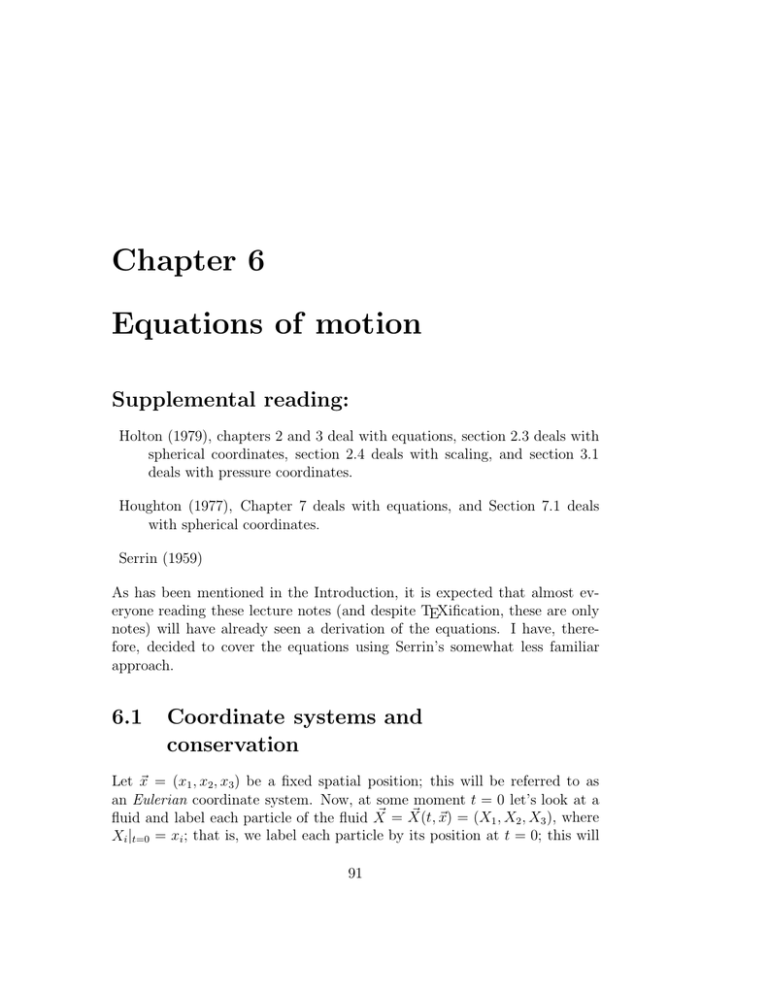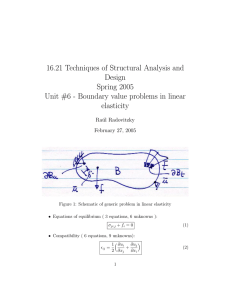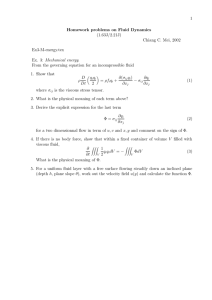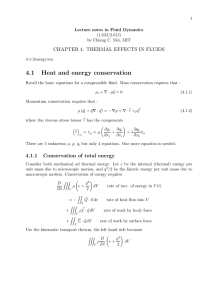Chapter 6 Equations of motion Supplemental reading:
advertisement

Chapter 6 Equations of motion Supplemental reading: Holton (1979), chapters 2 and 3 deal with equations, section 2.3 deals with spherical coordinates, section 2.4 deals with scaling, and section 3.1 deals with pressure coordinates. Houghton (1977), Chapter 7 deals with equations, and Section 7.1 deals with spherical coordinates. Serrin (1959) As has been mentioned in the Introduction, it is expected that almost ev­ eryone reading these lecture notes (and despite TEXification, these are only notes) will have already seen a derivation of the equations. I have, there­ fore, decided to cover the equations using Serrin’s somewhat less familiar approach. 6.1 Coordinate systems and conservation Let �x = (x1 , x2, x3) be a fixed spatial position; this will be referred to as an Eulerian coordinate system. Now, at some moment t = 0 let’s look at a � =X � (t, �x) = (X1 , X2 , X3 ), where fluid and label each particle of the fluid X Xi |t=0 = xi ; that is, we label each particle by its position at t = 0; this will 91 92 Dynamics in Atmospheric Physics be referred to as a Lagrangian coordinate system. In general, each coordinate system may, in principle, be transformed into the other: � t) �x, t �x = �x(X, � t X � = X(� � x, t) X, Eulerian: Lagrangian: Let the velocity of a fluid ‘particle’ be �u = (u1 , u2, u3). Dxi ui = = Dt � ∂xi ∂t � . � constant X Similarly, let �a be the acceleration of a fluid ‘particle’: ai = � ∂ 2 xi ∂t2 � = � constant X ∂ui ∂ui Dxj + , ∂t ∂xj Dt where the summation convention is used; that is, we sum over repeated indices. The laws of physics are fundamentally conservation statements concern­ D of something following the fluid. Let us, for the moment, deal with ing Dt some unspecified field f(xi , t) (per unit mass): Df ∂f ∂f Dxi = + . Dt ∂t ∂xi Dt Now consider some region of space R(�x). We wish to evaluate D Dt � R(� x) fρ d3 x, where ρ is density. A difficulty arises since the fluid within R(�x) is changing. We deal with this by switching to Lagrangian coordinates: D Dt where � D fρ d x = Dt R(x �) 3 � �) R(X fρJ d3 X, 93 Equations of motion � � � � � � � � ∂(x ) � � i � � � = �� J = � � ∂(Xi ) � � � � � ∂x1 ∂X1 ∂x1 ∂X2 ∂x1 ∂X3 ∂x2 ∂X1 ∂x2 ∂X2 ∂x2 ∂X3 ∂x3 ∂X1 ∂x3 ∂X2 ∂x3 ∂X3 � is fixed in the moving fluid, Since X D Dt � R(� x) fρ d3 x = � �) R(X � � � � � � � . � � � � � D (f ρJ ) d3 X. Dt For conservation of mass, we take f = 1. Then D Dt � R(� x) ρ d3 x = � � R(X) D (ρJ ) d3 X = 0, Dt and since R is arbitrary, D (ρJ ) = 0. Dt (6.1) This is a somewhat peculiar form of the continuity equation. It is, however, easily converted to the usual form: D DJ Dρ (ρJ ) = ρ +J , Dt Dt Dt 1 DJ J Dt = ∂(u1 ,x2 ,x3 ) ∂(X1 ,X2 ,X3 ) ∂(x1,x2 ,x3 ) ∂(X1 ,X2 ,X3 ) = ∂u1 ∂u2 ∂u3 + + = � · �u ∂x1 ∂x2 ∂x3 + ∂(x1 ,u2 ,x3 ) ∂(X1,X2 ,X3 ) ∂(x1 ,x2 ,x3 ) ∂(X1,X2 ,X3 ) + ∂(x1,x2 ,u3 ) ∂(X1 ,X2 ,X3 ) ∂(x1,x2 ,x3 ) ∂(X1 ,X2 ,X3 ) and Dρ + ρ� · �u = 0 Dt (6.2) 94 Dynamics in Atmospheric Physics Returning to the general case D Dt � R(� x) fρ d3 x = � = � = � = �) R(X �) R(X �) R(X � R(� x) D (f ρJ ) d3 X Dt ⎧ ⎪ ⎪ ⎨ Df ⎪ ⎪ ⎩ Dt ρJ + f D (ρJ ) d3 X ⎪ Dt ⎭ � �� �⎪ =0 Df ρJ d3 X Dt Df 3 ρ d x, Dt ⎫ ⎪ ⎪ ⎬ D that is, we can move Dt inside an integral within Eulerian space. Note also, D is applied to f not ρf. Dt 6.2 Newton’s second law – for fluids Newton’s second law for a volume of fluid, R, is � � D ρui d3 x = ρfi d3 x Dt � R �� � � R �� � momentum body f orce + � �S σij nj dS, �� (6.3) � f orce exerted on surf ace of R by f luid outside R � � N.B. S σij nj dS can be rewritten S Fi dS, where the surface force, F� , is given by Fi = σij nj (�n is the outward normal). The stress tensor, σij , represents the flux of i-momentum in the minus j-direction (recall that �n is the outward normal whereas we are considering the force exerted on S by the fluid outside R.). Intuitively, we expect the flux of i-momentum in the i-direction to be related to pressure. Now, 95 Equations of motion � D � Dui 3 3 ρui d x = ρ d x. Dt R Dt R Also, by the divergence theorem, � S σij nj dS = � R ∂σij 3 d x. ∂xj Finally, since R is arbitrary, we have ρ ∂σij Dui = ρfi + . Dt ∂xj (6.4) Note that ρ is outside the derivative. Equation 6.4 is not the usual form of the momentum equation (in particular, the pressure gradient term is buried in ∂σij ∂σ ); as our first step in evaluating ∂xijj , we will consider angular momentum: ∂xj D Dt � 3 R �r × ρ�u d x = � R ρ�r × f� d3 x + � S �r × F� dS, (6.5) where F� = σij nj îi 1. (Note that (6.5) assumes no intrinsic torques.) Rewriting (6.5), � �R 1 2 ρ � D (�r × �u) d3 x = ρ�r × f� d3 x + Dt �� � �R �� � A B � � ˆii ∂ (�ijk xj σkl ) d3 x 2 . R ∂xl �� C � The quantity îi is a unit vector in the i-direction. The quantity �ijk is called an alternant and is defined as follows �ijk ≡ ≡ ≡ 1 for ijk = 123, 231, 312 −1 for ijk = 321, 213, 132 0 when any two of ijk are equal. Similarly, note that δij is the Kronecker Delta, where δij = 1 if i = j, and δij = 0 if i = � j. 96 Dynamics in Atmospheric Physics ⎡ ⎤ u � ���� ⎢ ⎥ � ⎢ D� r D�u ⎥ ⎢ ⎥ d3 x ×�u +�r × A = ρ⎢ Dt ⎥ R ⎣�Dt�� � ⎦ =0 B = � R �r × � D�u ∂σij − ρ îi Dt ∂xj � � �� � d3 x =f� from Newton’s second law C = � � � ∂σkl 3 d x. îi �ijk δjl σkl + �ijk xj ∂xl R After obvious cancellation, we are left with � R îi �ijk δjl σkl d3 x = 0 or îi �ijk δjl σkl = 0 or î(σ32 − σ23) + ĵ(σ13 − σ31) + k̂(σ12 − σ21) = 0. Thus, in the absence of intrinsic torques σij = σji . 6.3 (6.6) Energy Let us first look at the rate of change of mechanical energy. Take the mo­ mentum equation (6.4), multiply by ui and sum over i: ρ � D ui ui Dt 2 Integrate (6.7) over region R � = ρfi ui + ui ∂σij . ∂xj (6.7) 97 Equations of motion A � D Dt � R �� � 1 ρui ui d3 x = 2 B �� R �� 3 � ρfi ui d x + � R ui ∂σij 3 d x. ∂xj The last term can be rewritten � R ui ∂σij 3 dx = ∂xj � � ∂ ∂ui (ui σij ) d3 x − σij d3 x R ∂xj R ∂xj � � ∂ui = ui σij nj dS − σij d3 x . S R ∂xj � �� � C The labelled terms are interpreted as follows: � �� � D Term A: Time rate of change of mechanical energy. Term B: Work done by body forces. Term C: Work done by surface stresses. Term D: Needs elucidation! Recall, there is no conservation of mechanical energy alone. What about total energy? D Dt � � u2 ρ + e d3 x = 2 R � � 3 R + ρfi ui d x + � S � S ui σij nj dS � · �n dS + −K � R ρQ d3 x (e = cV T , cV = heat capacity at constant volume, Q = external heating, and � = heat flux). In view of the arbitrariness of R, K D ρ Dt � � u2 ∂ � + ρQ. + e = ρfi ui + (σij ui ) − � · K 2 ∂xj Subtract from the above the relation for kinetic energy: 98 Dynamics in Atmospheric Physics ρ De ∂ui � + ρQ. = σij −�·K Dt ∂xj (6.8) Equations 6.2, 6.4, 6.6, and 6.8 are our equations of motion – so far. 6.4 � and σij K � and σij is usually (and properly) discussed in terms of molec­ The nature of K ular collisions and/or turbulent mixing. We will take a somewhat different approach here. Let us assume � � � =K � ρ, T, ∂T . K ∂xi Taylor expanding in ∂T ∂xi we get (0) Ki = Ki (ρ, T ) + Aij (ρ, T ) ∂T + ... . ∂xj (0) In general, Ki = 0. If we also assume transport to be isotropic then Aij must be proportional to δij ; that is, Aij = −k(ρ, T )δij , and � = −k(ρ, T )�T. K (6.9) This result is, of course, far more convincingly obtained by kinetic theory considerations. Following a similarly abstract approach for σij we will assume σij = σij � � ∂uk ρ, T, . ∂xl (Fluids satisfying this assumption are known as Newtonian fluids.) Taylor expanding the above relation we get 99 Equations of motion σij = Bij (ρ, T ) + Cijkl (ρ, T ) ∂uk + ... . ∂xl Again we want Bij and Cijkl to be isotropic tensors. Bij = − p ���� δij pressure Cijkl = λδij δkl + µ (δik δjl + δjk δil ) +ν (δik δjl − δjk δil) � Since σij = σji , ν ≡ 0 and �� symmetric in i,j � � �� � antisymmetric in i,j � � �� � ∂ui ∂uj σij = −pδij + λδij � · �u + µ + , ∂xj ∂xi � τij , the viscous stress tensor (6.10) where µ ≡ first viscosity and λ ≡ second viscosity. The expression for τij is a little more complicated than the most common expressions. Stokes suggested that average normal viscous stress should be zero; that is, τii = 3λ�·�u +2µ�· �u, which implies λ + (2/3)µ = 0. The quantity η = λ + (2/3)µ is called the bulk viscosity and is zero for spherical molecules – but not otherwise. Still, for incompressible fluids where � · �u ≡ 0, the second viscosity is irrelevant. Also, if µ and λ are constant � ∂ ∂ ∂ 2 ui ∂ 2 uj τij = λ (� · �u) + µ + ∂xj ∂xi ∂xj ∂xj ∂xi ∂xj � or îi ∂τij = (λ + µ)�(� · �u) + ∂xj ∂ui With (6.10), σij ∂x in (6.8) becomes j σij µ�2�u � �� � most commonly considered term ∂ui = −p� · �u + Φ, ∂xj . 100 Dynamics in Atmospheric Physics ∂ui where Φ ≡ τij ∂x . Φ represents dissipation by viscosity. It can be shown that j Φ ≥ 0 if and only if µ ≥ 0, η ≥ 0. Using (6.9) and (6.10), and replacing fi îi with �g , (6.4) and (6.8) become ρ Dui ∂p ∂τij = ρgi − + Dt ∂xi ∂xj (6.11) and ρcV DT + p� · �u = � · (k�T ) + ρQ + Φ. Dt (6.12) Note that Φ is generally small for typical geophysical scales. 6.5 Equations of state Equations 6.2, 6.11, and 6.12 represent five equations in six unknowns ui , ρ, p, T . The remaining equation is the equation of state. Several choices are com­ monly made. Perfect gas: Boussinesq fluid: homogeneous, incompressible fluid: p = ρRT (6.13) ρ = ρ0 (1 − α(T − T0 )) (6.14) ρ = constant. (6.15) In Equation 6.12 it is common to rewrite the left-hand side as follows: ρcV DT DT p Dρ DS + p� · u � = ρcV − = ρT , Dt Dt ρ Dt Dt where S is entropy; note that thermodynamic equilibrium has been assumed. For a perfect gas DS Dt cv DT R Dρ − T Dt ρ Dt � � cv D T = ln . Dt ρR = (6.16) 101 Equations of motion The relation between S and potential temperature (Θ ≡ T cV /R /ρ) is obvi­ ous. For the Boussinesq fluid, S is proportional to T (or ρ), while for an incompressible, homogeneous fluid S is irrelevant. 6.6 Rotating coordinate frame Consider a rotating frame (x�, y �, z �). A given position �r can be represented �r = x(t)î + y(t)ĵ + z(t)k̂ = x�î� + y �ĵ � + z �k̂ � (inertial frame) (rotating frame). The velocity in the inertial frame can be written D�r Dt Dx� � Dy � � Dz � � = î + ĵ + k̂ Dt Dt Dt � �� � �u = velocity in rotating f rame + Dî� Dĵ � Dk̂ � + y� + z� Dt Dt� � Dt �� x� velocity of particle f ixed in rotating f rame: ω � ×� r So, � = �u� + �ω × �r u and � D D = Dt Dt � rot + �ω × . Thus for �u = �u� + ω � × �r, . 102 Dynamics in Atmospheric Physics D�u = Dt � � D�u D�r + �ω × Dt rot Dt � � D = (�u� + ω � × �r) + ω × (�u� + �ω × �r) Dt � rot � D�u� = +ω � × �u� + �ω × u � � + �ω × (ω � × �r) . Dt rot Now, �ω (�ω · �r) � ) = −ω 2R ω2 (viz Figure 6.1). �ω × (�ω × �r) = (�ω · �r)�ω − ω 2�r = −ω 2(�r − Figure 6.1: Centrifugal contribution to geopotential. Thus, in a rotating frame, (6.11) becomes 103 Equations of motion ⎛ u ⎜ D� ρ⎝ � Dt ⎞ Coriolis f orce � �� � + 2�ω × �u� ⎠ = −�p + � · �τ ⎟ � ω 2 R2 + ρ�g + ρ� 2 � �� � . (6.17) � usually combined as −ρ�Ω where Ω ≡ geopotential. Note that, because of isotropy, the viscous term is the same in rotating and non-rotating systems. 6.7 Spherical coordinates We shall not derive the spherical equations here. The task is straightfor­ ward. The most direct approach involves transforming our equations into vector-invariant form (note that �u · � is not vector-invariant), and then em­ ploying spherical forms for the invariant operations. Here we will merely write down equations discussed in Holton (his section 2.3; N.B. Holton uses an approach different from what we have just described). Holton considers a quasi-cartesian system on the surface of the earth (see Figure 6.2). Sphere Cartesian tangent plane r = a + z dz w = dz dt λ dx = a cos φ dλ u = a cos φ dλ dt φ dy = a dφ v = a dφ dt If we define d ∂ ∂ ∂ ∂ ≡ +u +v +w , dt ∂t ∂x ∂y ∂z then the equations for u,v, and w become 104 Dynamics in Atmospheric Physics Figure 6.2: Spherical coordinates with cartesian tangent plane. du uv tan φ uw 1 ∂p − + = − + 2Ωv sin φ dt a a ρ ∂x 1 −2Ωw cos φ + (� · τ )x ρ (6.18) 1 ∂p 1 dv u2 tan φ vw + + =− − 2Ωu sin φ + (� · τ )y dt a a ρ ∂y ρ (6.19) dw u2 + v 2 1 ∂p 1 + =− − g + 2Ωu cos φ + (� · τ )z . dt a ρ ∂z ρ (6.20) (What about equations for energy, continuity, and the gas law?) 6.8 Scaling Scaling is an approach to non-dimensionalization which ideally permits or­ dering terms in an equation according to their size. For any variable, f, we 105 Equations of motion may write ˜ f = F f, where F f˜ = = characteristic magnitude O(1) non-dimensional quantity . Such a redefinition leads to non-dimensional parameters which indicate the relative importance of various terms in equations. Some of the more famous non-dimensional numbers, and the physical balances they represent, are Rossby No.: Froude No.: Reynolds No.: Ekman No.: U inertia ∼ 2ΩL Coriolis force gL gravity Fr = 2 ∼ U inertia LU inertia Re = ∼ ν friction Ro ν friction Ek = = ∼ , 2 Re 2ΩL Coriolis force Ro = (where ν ≡ µ/ρ). Note that there is little sense in scaling pressure in the absence of either data or the size of other numbers. The following are some serious problems with scaling: 1. Northerly, westerly, and vertical scales and velocities are not necessarily the same. 2. Several scales for a single variable may be present in a single problem. 3. Not all variables are measured. Ultimately, scaling actually requires that we already have knowledge of the answer! The following sections deal with some specific examples of scaling. 106 Dynamics in Atmospheric Physics 6.9 Hydrostaticity As already noted, hydrostaticity is, in general, an approximation. We will use scaling to estimate the conditions needed for hydrostaticity to be a good approximation. One is tempted to note that g turns out to be much larger than any acceleration or stress in Equation 6.20 – at least for most meteo­ rological and oceanographic systems. Thus, one might argue that the only ∂p . This would, however, be a possibly misleading term left to balance g is ρ1 ∂z statement. To see why, let us write p = p0 (z) + p� (x, y, z, t) ρ = ρ0 (z) + ρ� (x, y, z, t) . The quantities p0 and ρ0 represent horizontal and time averages; the primed quantities represent deviations from these averages. In general, the averaged quantities dominate the above expressions; however, for stable stratification3 , the averaged terms are not directly involved in the dynamics (which depends on gradients of pressure, density, etc.). Scaling must be done after p0 and ρ0 (and T0) have been subtracted from p and ρ (and T ). The evaluation of the term ρ�g in Equation 6.20 then requires knowing how ρ� is related to w, and so forth. It is here that one has to involve the energy equation in the scaling, and one discovers that a necessary condition for hydrostaticity to hold is that Nτ � 1 (where N is the Brunt-Vaisala frequency and τ is a characteristic time scale). This is most easily seen for a linearized adiabatic Boussinesq fluid where (6.20) becomes ρ ∂w ∂p ∼ −gρ − . ∂t ∂z (6.21) 0 Now, ρ = ρ0 + ρ� , and ∂p = −gρ0 . Subtracting these from (6.21), we get for ∂z our vertical momentum equation ρ0 3 ∂w ∂p� ∼ −gρ� − . ∂t ∂z We’ll explain what this means soon. 107 Equations of motion Similarly, the Boussinesq energy equation becomes ∂ρ� dρ0 +w ∼ 0. ∂t dz For convenience, let our variables have the following time dependence: eiωt . The last two equations become ρ0 iωw ∼ −gρ� − iωρ� ∼ −w ∂p� ∂z dρ0 . dz Eliminating w from the above equations yields � ρ0 ω 2 dρ0 dz � ρ� ∼ −gρ� − ∂p� , ∂z from which we see that hydrostaticity requires that � � � ρ ω2 � � 0 � � dρ � � 1, �g 0 � dz or � � � ω2 � � � � 2 � � 1, �N � 0 where N 2 ≡ − ρg0 dρ . The quantity N is called the Brunt-Vaisala frequency dz and is a measure of the stratification. When N 2 < 0, the fluid is statically unstable (that is, we have heavier fluid on top of lighter fluid)4. 4 We will have much more to say about both the Brunt-Vaisala frequency and static stability in later chapters. 108 Dynamics in Atmospheric Physics 6.10 Geostrophy In terms of scaling, one commonly finds that Ro � 1 and Ek � 1 so that pressure gradients primarily balance the Coriolis force. We also saw this directly in the data. Nevertheless, the existence of this approximate balance, alone, does not permit us to calculate the time evolution of flow fields. In order to exploit Ro � 1 to calculate the time evolution of almost geostrophic fields we will have to perform a more sophisticated scaling analysis (not too different from what we just did in connection with hydrostaticity) which leads to what are called the quasi-geostrophic equations. We will defer this analysis until a later chapter. Before ending this chapter, an important aspect of geostrophic balance needs to be mentioned and pondered: namely, in the absence of viscosity, thermal conductivity, and x-variation, the following geostrophic flow is an exact solution of the nonlinear equations: T (y, z) p, ρ u v=w as determined from Q = 0; that is, radiative equilibrium; as determined from hydrostaticity and the gas law; as determined from geostrophy; and =0. The intrinsic difficulties with the above solution will form the focus for much of our discussion in Chapter 7.


